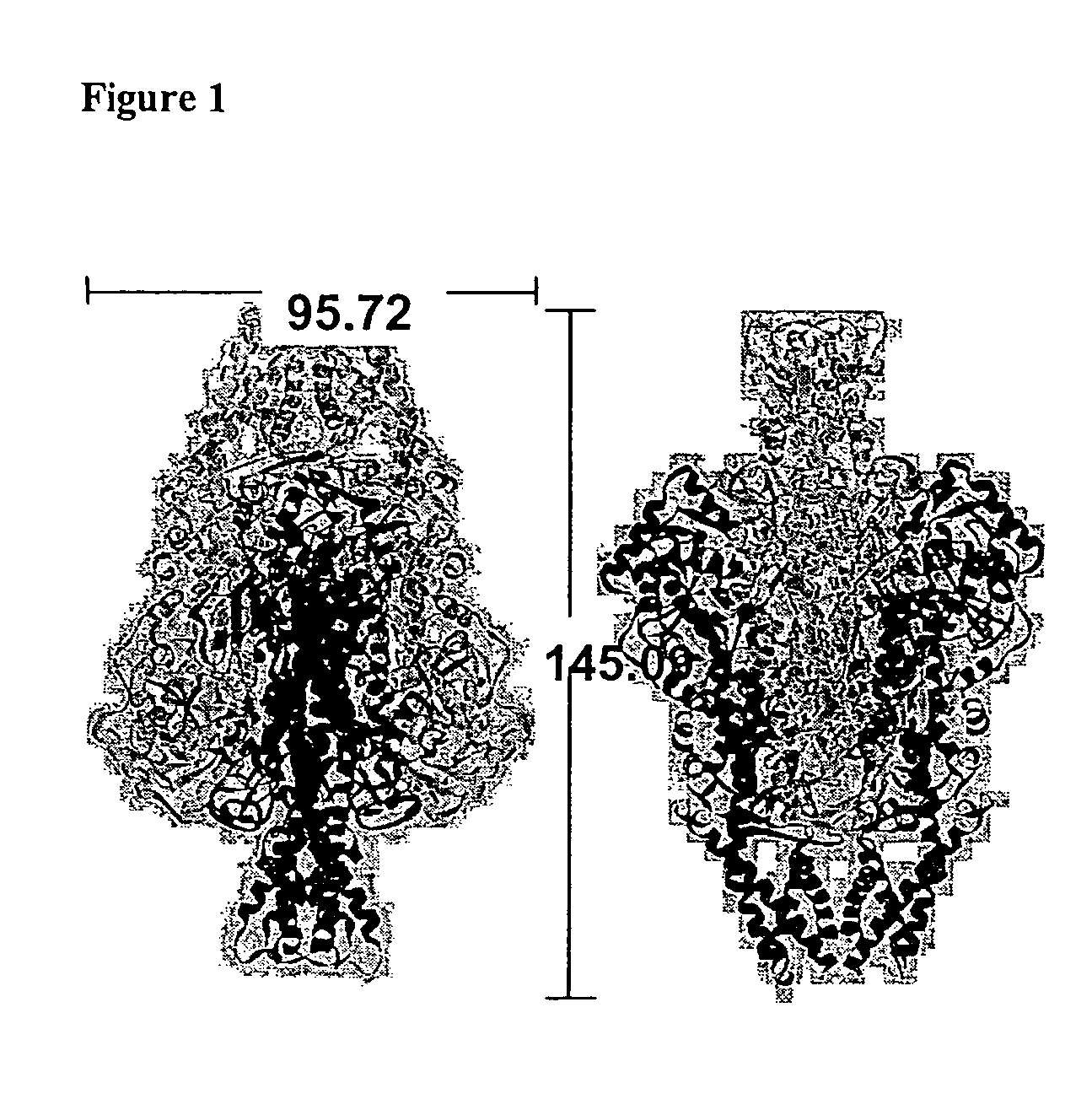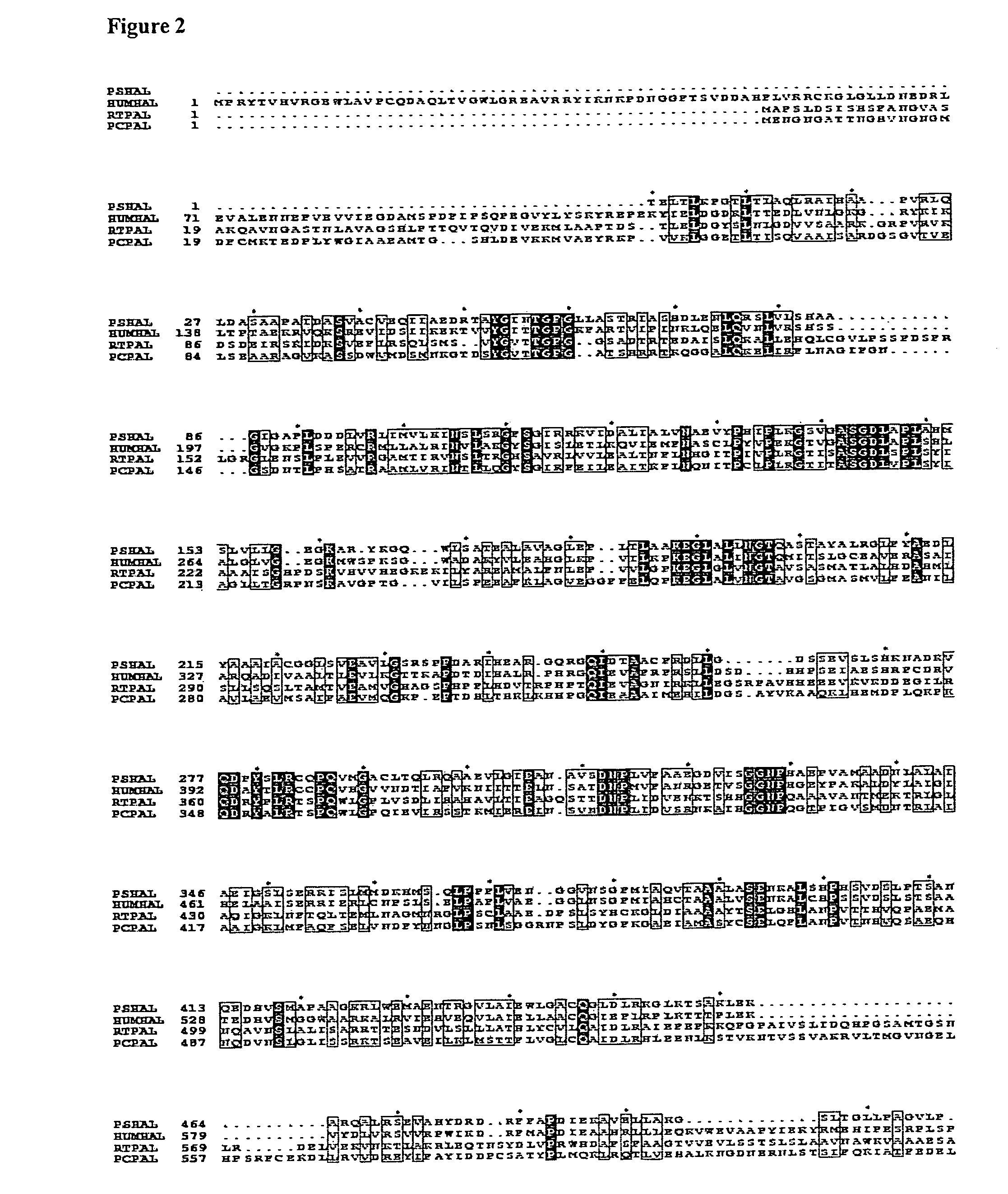Variants and chemically-modified variants of phenylalanine ammonia-lyase
a phenylalanine ammonialyase and ammonia-lyase technology, applied in the field of phenylalanine ammonialyase (pal), pal analogs, can solve the problems of reduced cognitive development, impaired neurophysiological functioning, and potential irreversible mental retardation, and achieve enhanced properties, potent catalytic activity, and greater biochemical stability
- Summary
- Abstract
- Description
- Claims
- Application Information
AI Technical Summary
Benefits of technology
Problems solved by technology
Method used
Image
Examples
example 1
Crystal Structure of PAL
PAL Protein Expression and Purification
[0199]Both a full-length R. toruloides PAL DNA clone (pIBX-PAL (Sarkissian, et al., 1999 ibid.), wt-PAL amino acid sequence (shown in FIG. 5) and a recloned construct in the His-tag-containing pET-28a(+) expression vector (Novagen) between NdeI and NotI restriction sites (pET-PAL) have been used. With the pET vector construct, the PAL protein was expressed with a thrombin-cleavable His tag on the N-terminus. The wild-type pET-PAL construct produces 3.5 mg / L levels of active PAL (versus 1 mg / L for the pIBX-PAL PAL construct) and provides for one-step immobilized metal affinity chromatography purification of PAL. Both forms of the PAL protein was used for crystallization trials.
[0200]His-tagged PAL was expressed in BL21(DE3) E. coli cells (Novagen) grown in LB medium with 30 μg / ml kanamycin at 37° C. with induction using 1 mM IPTG at an OD600 of 0.8. The temperature was reduced to 23° C. and expression proceeds for 3 hours...
example 2
Structure of Human Histidine Ammonia-Lyase (HAL)
[0214]The three-dimensional structure of residues 114-607 of human HAL (FIG. 6) was modeleled using the JIGSAW server available over the internet (www.w3.org / Jigsaw / ) based upon the 3-D structure of P. putida HAL (427 Schwede, et al., (1999) ibid.). Human HAL has 657 amino acids in total with a core that is homologous to P. putida HAL, but N- and C-termini display differences.
example 3
Confirmation of the Active Site of PAL
[0215]The active site of PAL was identified based on the combined information from the comparison to the HAL structure, sequence alignments, mechanistic studies and site-directed mutagenesis. PAL has the same active site MIO prosthetic group as HAL that is formed by residues Ala211, Ser212, and Gly213. We define residues in the R. toruloides PAL active site that are within 5 Å of the MIO. The PAL active site consists of residues from three different monomers in a PAL tetramer, including residues from monomer A (A138, A208-A218, A266, A270-A272, A274-A275, A395-A396, A411-A415, A496, A499-A500, and A502-A505), residues from monomer B (B360, B363, B366-B367, and B370-B371), and residues from monomer C(C472). All residues in the R. toruloides PAL active site are from domains D1 and D2. The flexible loop region A106-A124 acts as a cover to the entrance of the active site. Most residues that have been proposed and characterized structurally and bioch...
PUM
| Property | Measurement | Unit |
|---|---|---|
| average molecular weight | aaaaa | aaaaa |
| molecular weight | aaaaa | aaaaa |
| concentrations | aaaaa | aaaaa |
Abstract
Description
Claims
Application Information
 Login to View More
Login to View More - R&D
- Intellectual Property
- Life Sciences
- Materials
- Tech Scout
- Unparalleled Data Quality
- Higher Quality Content
- 60% Fewer Hallucinations
Browse by: Latest US Patents, China's latest patents, Technical Efficacy Thesaurus, Application Domain, Technology Topic, Popular Technical Reports.
© 2025 PatSnap. All rights reserved.Legal|Privacy policy|Modern Slavery Act Transparency Statement|Sitemap|About US| Contact US: help@patsnap.com



